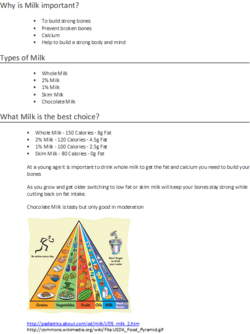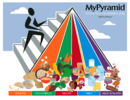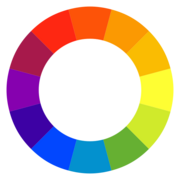Tie-Dye Milk
| Instant wiki maker | Making handouts | Editing tips |
Biology In Elementary Schools is a Saint Michael's College student project from a course that ran between 2007 and 2010 and fully described in this book chapter. The student-created resources have been preserved here for posterity. Link under 'toolbox' for printer-friendly versions of the exercises. Click on handouts to print full resolution versions. Please see Wikieducator's disclaimer, our safety statement, and the Creative Commons licensing in English and in legalese.
Student worthiness
This project has been tested and approved by many scientists of all ages! It was created for students in the first grade.
Primary biological content area covered
Briefly list the concepts to which this activity will expose students.
Materials
- disposable cups
- whole milk
- food coloring
- glue
- detergent
- paper towels
Handouts
Description of activity
This activity will create beautiful and colorful designs in your cup of milk, using simple, household materials! As you add the detergent into the milk, it reduces the surface tension and dissolves the fat molecules. The more fat in the milk the better! As the detergent pulls the surface away from the spot in which you dropped it, watch your milk become tie-dye before your eyes! ZoomScience
Lesson plan
- First, let the milk warm up a little first. This makes it easier to see the colors!
- Brainstorm with the students what they think will happen in the experiment
- Record the ideas
- Now it's time to start the experiment
- Pour the milk into the disposable cups
- Put one drop of food coloring (3 different colors), in the shape of a triangle or square, into the milk
- Put one drop of detergent in the middle of the design
- Watch as the colors combine!
Further Learning...
- Repeat the same steps, but replace the milk with glue
- Let it harden, and peel away the cup
- Now you have a beautiful tie-dye milk disk to take home!
- Photographs of the experiment in progress
Potential pitfalls
There is always a chance that the colors will not mix or will mix so well that they will become one color. Using milk with a higher or lower fat content may also change the results.
Nutritional connections
Why is Milk important?
- To build strong bones
- Prevent broken bones
- Calcium
- Help to build a strong body and mind
Types of Milk
- Whole Milk
- 2% Milk
- 1% Milk
- Skim Milk
- Chocolate Milk
What Milk is the best choice?
- Whole Milk - 150 Calories - 8g Fat
- 2% Milk - 120 Calories - 4.5g Fat
- 1% Milk - 100 Calories - 2.5g Fat
- Skim Milk - 80 Calories - 0g Fat
- At a young age it is important to drink whole milk to get the fat and calcium you need to build your bones
- As you grow and get older switching to low fat or skim milk will help keep your bones strong while cutting back on fat intake.
- Chocolate Milk is tasty but only good in moderation
Artistic connections
In this science experiment, the students will observe three colors in the milk that will combine and potentially create new colors. This experiment is a helpful tool to expand upon color combinations and the color wheel!
Primary Colors
- Red
- Yellow
- Blue
The three primary colors on the color wheel are placed equidistant from one another. They cannot be mixed or formed by any other colors. All colors are formed from these three colors.
Secondary Colors
- Green
- Orange
- Purple
The secondary colors are formed by two primary colors.
Tertiary Colors
- Red-orange
- Red-violet
- Yellow-orange
- Yellow-green
- Blue-violet
- Blue-green
These colors are created by both the primary and secondary colors.
Quick Facts About the Color Wheel
Sir Isaac Newton was the first person to create the circular diagram of colors.
Scientists and artists have studied and developed color combinations and theories regarding the color wheel.
The color wheel is arranged based on the colors' chromatic relationships.
Colors that are directly across from each other on the color wheel are called Complementary Colors.
Colors that are close together on the color wheel are known as Analogous Colors.
color wheel color wheel information
Connections to educational standards
This experiment is connected to many Vermont Educational Standards, including:
1.13 Students listen actively and respond to communications
7.2 Students design and conduct a variety of their own investigations and projects
7.5 Students analyze the roles and responsibilities of scientists, mathematicians, and technologists in social, economic, cultural, and political systems
Information on Vermont standards taken from Vermont Department of Education
Next steps
Take what you learned through this experiment into your own life! What did you learn about milk, and the nutritional values that it has? What type of milk is better for you? Based on the findings in this experiment, the dish soap separates the fat in the milk, just like it does to the grease on your dirty dishes. The food coloring takes the place of the fat in the milk. If we had done this experiment with skim milk, the colors would not have blended as well. In regards to nutritional values, fat needs to be consumed in moderation.
Reflections
Edit this section after you have tried the activity with grade school students. What worked well? What was unexpected? What previous knowledge did the students bring to the activity and how did that compliment your lesson? Are there any must do components that did or would particularlly enhance the learning experience? Other helpful thoughts.
- I felt that the experiment ran smoothly with the first grade students. Each student seemed to be interested in the process as well as creating their own. For the majority of the groups the large demonstration worked well in the bowls. The goal was to show the students what would happen with skim milk (with less fat) in comparison to the whole milk. Surprisingly once or twice the skim milk seemed to work better than the whole milk. This was not supposed to happen, however could have been the result of too little soap or food coloring. The students seem very interested in learning about the milk they drank and were constantly asking questions. Overall it was a great experience. (Maggie)
- I think that this experiment went very well with the first graders. We had very few, if any problems, and the students seemed to be very interested in what we were doing. I think doing the experiment in the bowls at first, then letting them do the same experiment in their individual cups was the perfect way to set it up. They were able to see how it worked, then were able to create the same process themselves. One time, much to our surprise, the skim milk actually worked better then the whole milk, which was not supposed to happen. Other times, it worked perfectly when we did it in the bowls. But, every time the students did it individually, it worked perfectly. We were a little worried that they weren’t going to be able to put the food coloring in the milk without making a huge mess, but they did a great job. They were all so excited when their personal experiment actually worked. We asked them about the nutritional values of milk, and they were very interested in learning which was healthier for them. They were eager to ask questions, and were very well behaved throughout the entire process. Overall, I think that this experiment ran very smoothly, and I look forward to doing more. (Eliza)
- Our tye-die milk experiment went well with the first graders from Mater Christi School. Initially, we were not going to demonstrate the process and just let the students do it individually but, I think that by demonstrating what we were going to be doing, and by letting the kids observe first was beneficial for them. They were able to see the differences between skim milk and whole milk when the food coloring and dish soap was added. It was easier to do this experiment with a smaller group because we could help a student one on one and there was more opportunity for each child to ask questions or answer one of our questions. The kids were really excited to see what we were going to do with them and overall I think that our experiment went well! Milk is very much apart of their lives, they drink it at school and at home, so having the chance to use something they like and are familiar with was an advantage. Although the majority of the students seemed to like chocolate milk the best, they knew a lot about other types of milk and the nutritional value they offer. Also, I was very impressed that the students knew the primary colors and it was fun to see their reactions to the swirling colors in the milk!(Megan)
- I feel that overall our project was a success. With most of the groups it ran very smoothly, although sometimes our skim milk worked better than our whole milk. Letting the students make their own project in cups worked well too because it let them be a part of the project instead of just watching us, which they were all very enthusiastic about. Not only that, but letting them try the experiment with glue took it one step further, and got them to think about why it worked differently. Tying our discussion about the health aspects of milk and the primary colors into the experiment also worked well because it was right in front of them and they could relate to it. We were really surprised by how much they already knew, but still felt that they learned something new. (Sara)
Citations and links
http://pbskids.org/zoom/activities/sci/colorsymphony.html
http://www.colourlovers.com/blog/2008/05/08/history-of-the-color-wheel/










